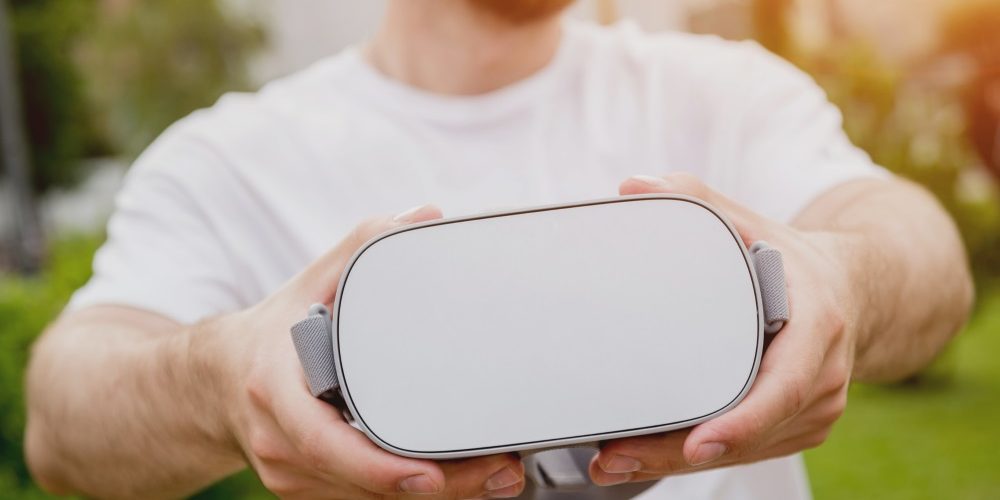The Oculus Go has delivered a new age of wearable technology and virtual reality (VR).
As a standalone device, the Oculus Go allows anyone to transport themselves into a virtual world without the need to connect to a PC – a requirement of its predecessor, the Oculus Rift.
Without needing a computer or smartphone, the Oculus Go is affordable, requires little setup, and only needs one thing to work: You.
The Oculus Go, manufactured by Facebook, provides users with an exciting new way to experience virtual reality.
The plush headset contains everything you need to run the device, while fitting comfortably on your face and providing outstanding visuals.
While the experience isn’t quite as good as that of the Oculus Rift, the Oculus Go provides an experience that is accessible to casual gamers who don’t want to spend the money or time on the high-end computer needed to power the Oculus Rift.
The Oculus Rift is VR for hardcore gamers; the Oculus Go is VR for everyone.
And at half the price of the Oculus Rift, the Oculus Go is a more-affordable option for people who are just discovering VR, or for parents who are wanting to give their children the experience of VR without spending too much money.
While the Oculus Go may not draw in a crowd of people waiting to buy it right away, the potential for it to drive people to want to try VR is certainly there.
Between in-store demo stations in Best Buy retail stores across the United States, and word of mouth from those who purchase it, it’s possible that the Oculus Go shows that virtual reality is getting closer to taking off.
Price & Availability
Oculus released the Oculus Go headset on May 1 in two versions: A 32GB one available for $199, and a 64GB one available for $249.
Both versions are identical, except for their capacity. For comparison, the Go’s predecessor, the Oculus Rift, is available for $399.
The Oculus Go is available in 23 countries, including the United States, Canada, the United Kingdom, and Australia.
Globally, you can purchase the Oculus Go from Oculus.com.
In the United States, the Oculus Go can also be found online at Amazon, Best Buy, and Newegg, and in-store at Best Buy.
You can also try out a demo of the Oculus Go at brick-and-mortar Best Buy stores.
Design
With a sleek, gray design, the Oculus Go makes you feel like you got your money’s worth as soon as you take it out of the box.
There are also a few subtle design touches, including the front panel that appears to be a different shade of gray in certain light.
The headset straps are comfortable and adjustable, though you may want someone to help you cinch the VR device, as it can be a bit awkward to tighten the straps while wearing it.
The VR headset feels secure once you modify it to fit your head, but having someone help you fix the straps can help keep it from sliding upwards.
Once you’ve adjusted the headset straps to your liking, the Oculus Go’s inner lining is plush and soft against your face, but doesn’t feel too heavy or thick; the lining is breathable and comfortable.
Oculus worked closely with the clothing industry to design the Go headset, allowing the company to provide a VR device with a superior, comfortable feel.
The Go also features injection foam molding and other wearable materials innovations, making its use comfortable for extended periods.
You’re also able easily to remove the foam pad surrounding the eye sockets; this makes cleaning the headset, and sizing it to fit you, much easier.
Though the headset is comfortable, its bridge of the nose area does allow some light to leak through.
This can affect the VR experience by breaking the immersion in the virtual realm; however, we found that some games were so engaging that we didn’t even notice it.
If you start to see the light leaking through and it begins to interrupt your experience, you can try operating the headset in the dark.
While perhaps not ideal, if a game requires that no outside light come in, it may help you feel fully immersed.
Because of the Oculus Go’s nature, and how everything it needs to operate is contained in the front of the headset, it tends to start feeling heavy after a while.
The headset rests on your cheekbones, and you may begin to experience a slight ache if you’ve been wearing it for some time.
Weight distribution tends to be a common issue in VR headsets, although the HTC Vive has minimized it quite well.
Even with a forward-heavy weight distribution, the Oculus Go is extremely comfortable, and the straps help adjust the weight distribution so that it’s not all lying on your cheekbones.
The Go is also slightly lighter than the Gear VR, but the difference is almost negligible.
The Oculus Go integrates audio extremely well. Instead of built-in headphones like some other premium VR headsets, the Oculus Go’s plastic arms have slits for the speakers.
With this design, the headset maintains a cohesive, immersive experience that isn’t broken by bulky headphones or tangled wires.
While the sound quality of the slots isn’t quite up to par with that of high-quality headphones, they give a sense of the ambient space in the world around you, which should help with your spatial awareness.
Because they are not inserted directly in your ears, those around you may be able to hear some of the sound, as well.
To address this issue, the Oculus Go does have a 3.5 mm audio jack, which will allow you to wear headphones, if that’s what you prefer.
While the headset boasts its wire-free nature, you cannot use Bluetooth headphones with the Oculus Go.
There is a volume rocker on the top of the device, but it can be awkward to use while wearing the headset.
A 3DOF controller is included with the Oculus Go.
The controller has responsive controls, and an ergonomic design that feels great in the hand. It features a touch surface, a trigger button, and “Back” and “Home” buttons.
The touch surface on the Oculus Go controller can’t pick up precise taps and directions; instead, it limits you to swiping up, down, left, and right.
This controller isn’t much more than a point-and-click remote, unlike the Oculus Touch controllers that come with the Oculus Rift.
The Touch controllers bring your hands into virtual reality, and track your hand and arm movements.
While the Oculus Go controller doesn’t provide the same level of immersion, it can move throughout the VR space, and it adheres to your movements faithfully.
Certain Oculus Go games, such as Coaster Combat, integrate the controller quite nicely, allowing you to do more than simply selecting different parts of the virtual world.
The controller instead can become part of the world you are seeing, such as a pistol to shoot and collect coins in Coaster Combat, making the controller feel intuitive, and adding to the immersive quality of the headset.
Still, there is plenty of room to improve the controller through better tracking or additional buttons.
Performance
Because virtual reality is still a relatively new technology, user expectations may be somewhat low for the Oculus Go, especially since it has a reputation as an affordable introduction to VR.
The Oculus Go, however, will exceed these low expectations.
Despite being less than half the price of its premium competition, the Oculus Go provides a comparable experience.
Even though Oculus doesn’t have the same game development reputation as Sony, the Go provides a comparable experience to that of the PlayStation VR headset.
Due to its similar experience to those of premium headsets – even as an affordable, standalone device – the Oculus Go raises expectations for new VR hardware, and what users should expect from the more expensive VR headsets, as well.
The Oculus Go does have one notable limitation: It offers an “Orientation Only” movement system, meaning you cannot move through the virtual space; the headset only detects rotational movement.
This means you can only turn your head and view the world in 360 degrees, and have your controller tracked your movements in that area.
Physically walking will not move you toward something happening in the distance in the virtual world.
This is where the premium headsets with the high price tags excel.
Because the Oculus Go is deemed an introduction to VR for the casual or beginner gamer, however, those who have never used a more-advanced VR headset may not even expect the freely-tracked movement component of the Oculus Rift or HTC Vive.
The tracked movement supported by the Oculus Go is accurate, easy, and comfortable, with only minor jerkiness onscreen; this decreases the chances of feeling nauseous that may occur with other VR headsets.
The Oculus Go has a fast-switch LCD display that is a 5.5 inch, 538 ppi panel with a resolution of 2560 x 1440.
Its resolution exceeds that of its pricier competitors, which is at 2160 x 1200, by 42%.
Although the overall hardware isn’t as advanced as that of the Oculus Rift or the HTC Vive, Oculus states the Go has the best visual clarity of all the virtual reality headsets it has produced to date.
Oculus designed the Go to have a better pixel fill than earlier headsets, meaning the pixels are larger and reduce the “screen-door” effect that plagued earlier headsets.
The screen-door effect is a grid-like pattern that’s seen whenever there’s a low pixel fill, and the Go’s better fill results in less unlit space between pixels.
The Go’s display is so sharp it almost completely eliminates the screen-door effect.
The Oculus Go has a slightly narrower field of view than the Oculus Rift and HTC Vive.
While these higher-priced headsets offer a default field of view of 110 degrees, the Oculus Go offers an FOV of roughly up to 101 degrees.
The Go’s field of view is still slightly wider than that of the Gear VR.
The Oculus Go’s frame rate is slightly lower than that of the premium VR headsets; the Oculus Go has a frame rate of 72Hz, while the more expensive, tethered VR headsets have one of 90Hz.
The front panel of the Oculus Go has been designed to reduce the chance of overheating, so you should never experience this issue while you’re wearing the headset.
Even when put through rigorous testing, the headset never gave a temperature warning.
Oculus also improved the goggles in front of the screen on the Oculus Go from those they had on the Oculus Rift, which decrease the glare onscreen.
They also included a glasses spacer accessory that, while a bit awkward to install, provides more room for comfortable viewing for those of us with glasses.
Some glasses, however, may fit easily and comfortably without the need of the spacer.
If you’d prefer, Oculus offers prescription lens inserts for the headset, if you don’t want to use the glasses spacer.
Available Experiences
So far, more than 1,000 apps, games, and other short-form VR experiences are available in the Oculus Store.
You can find anything from action-heavy games to emotional stories to movies and even educational apps.
Some are brand-new, built specifically for the Oculus Go, while others are remade Oculus Rift and Samsung Gear VR titles.
The Oculus Store has its own payment and update systems that you manage through the Oculus app on your phone.
Although the headset runs on Android, the Oculus app is available for iOS users, as well.
Because Oculus has a relatively relaxed submission system for apps, the quality of the available experiences will vary, but the selection is vast.
You may have to search a little harder to find content that is really great among a plethora of subpar offerings.
Occasionally the load times will be longer than you’d prefer, but once loaded, many games look impressive on the Oculus Go, even without the external processing associated with other headsets.
The Oculus Go has a Snapdragon 821 processor, similar to those found in today’s smartphones.
One of the best experiences available is the new Oculus Rooms app, Oculus’s customizable social space that you can share with your friends, no matter where they are in the real world.
You will be able to customize your room with furniture and in various styles, and you can decorate your walls with pictures from Facebook.
Once you invite your friends to your own space in Oculus Rooms, you can play tabletop games, watch TV shows or movies, listen to music, share photos, or even jump into other apps together.
It’s similar to a Ready Player One experience. These shared social spaces are flexible and powerful, and are opening new doors in the virtual reality realm.
Although Oculus Rift games can’t be played on the Oculus Go, app and game developers who design for the Gear VR should find it easy to build versions for the Go.
The Oculus Go also supports cross-platform play with the Oculus Rift and the Gear VR, so will be able to play with friends who own the Rift or Gear VR while wearing your Oculus Go.
Battery Life
While Oculus’s measurements of battery life are fairly accurate at two hours of gameplay from a three-hour charge, or 2.5 hours of video for the same charge, those measurements change when you are downloading apps in the background while using the headset.
The Oculus Go comes with a micro-USB cable for charging, which seems odd given the current shift toward USB-C cables.
To avoid draining your battery while using the headset, you can connect your Oculus Go to your phone to download apps.
The actual battery life will also depend on the type of game you are playing, and what brightness level you are using inside the headset.
Since you have to charge it for three hours to get two hours of gameplay, the charge time may make it difficult to share the Oculus Go within a household.
It’s unlikely, however, that you’ll want to spend an uninterrupted two hours inside the VR headset, so the charge time may not have as much of a negative impact as you might initially think, unless you are watching a long movie.
We also found that, on rare occasions, the Oculus Go may skip frames when the battery runs extremely low.
For a VR headset that doesn’t have to rely on an external processor or power source, the Oculus Go’s battery life is acceptable, and the device delivers an approachable, fantastic VR experience.
Verdict
Bottom line: The Oculus Go is worth it. It offers an excellent, immersive, and enjoyable virtual reality experience.
Even though the experience isn’t quite up to par with that of premium VR headsets that must be tethered to a computer, the Go is an excellent standalone device.
From the comfort of the device to the high-quality screen to the ergonomic controller to the varied experiences, the Oculus Go package has it all.
Because the experience is so dynamic, it’s easy to forget that the entire system is running entirely on its own.
It may not be perfect, but it provides a completely enjoyable experience, especially for those who are new to VR.
The wireless headset means that you don’t have to use a specific phone to try awkwardly to lock into the headset.
It also means you don’t have to drain your phone battery, and you don’t have to miss any important notifications.
It also means that you don’t need a high-end gaming computer to venture into the exciting new realm of VR.
The Oculus Go is not meant to compete with the Oculus Rift.
Facebook imagines virtual reality as a spectrum; those who want a high-end experience can purchase the Oculus Rift, while those who want a portable, or more casual, experience can purchase the Oculus Go or the phone-powered Samsung Gear VR.
One of the biggest advantages of the Oculus Go is its social virtual reality spaces.
Oculus Rooms allows you to “hang out” in the same virtual space with your friends and family from anywhere in the world, essentially making virtual reality a social experience.
Because Oculus is owned by Facebook, you can easily assume that Facebook has the goal of making VR social, and they seem to have accomplished this goal through the combination of Oculus Go and Oculus Rooms.
The price cannot be beat for its value.
The Oculus Go is not inexpensive at almost $200, and some people may be wary of the price tag for a device that is meant purely for entertainment.
However, with everything you get with the Oculus Go, the cost is worth it. It’s a premium product, and you can tell this as soon as you take it out of the box.
With more time and interest, the Oculus Go is sure to inspire developers to make amazing virtual reality games, apps, and other experiences.
Best of all, the Oculus Go is a full entertainment system designed for everyone that you can bring with you anywhere.
What is VR?
Just a few years ago, virtual reality, or VR, was just a science fiction concept.
In just a few short years, it’s become a distinct market that offers multiple consumer devices.
Virtual reality is the use of technology, generally with a computer, to place the user into a simulated environment.
Instead of simply viewing a screen, like watching television, users of virtual reality are immersed into the digitally-created 3D world, and can interact with it.
The goal of virtual reality technology is to create a realistic three-dimensional environment that you can perceive as real, and with which you can even interact in realistic ways.
For example, with some virtual reality technology, when you walk forward in the real world, your headset will move you forward in the virtual reality world.
While there’s still a long way to go in order to create a fully immersive experience through virtual reality, consumers can now easily purchase VR headsets and controllers.
VR in devices like the readily-available headsets is created by a mixture of both hardware and software.
This makes it different from augmented reality, commonly referred to as AR, which adds objects to an overlay of the real world, like the Microsoft HoloLens.
Virtual reality is a much more difficult initiative than augmented reality because AR has solid, fixed reference points in the real world that your eyes can use to track, navigate, and orient yourself.
In virtual reality, the entire environment is digitally simulated; without the real-world reference points, realism is harder to attain in VR than in AR.
The most common VR product on the market is the VR headset.
There is currently a wide variety of these, ranging from the Google Cardboard to the Oculus Rift.
Virtual reality headsets are typically divided into categories based on the hardware they need to operate: Large, high-end headsets like the Oculus Rift are designed to work with computers that are able to run VR software; slightly smaller VR headsets like the PlayStation VR are designed to run on game consoles; other VR headsets like the Samsung Gear VR need a smartphone to operate; and now VR headsets like the Oculus Go can stand alone, as they have all the necessary hardware included in the headset itself.
Level of immersion is arguably the most important aspect of VR technology, and there are three:
- Non-immersive: Allows elements of the real world to creep into the experience, which can help prevent nausea.
- Semi-immersive: Displays a combination of virtual and real-world objects for a moderately-immersive experience.
- Fully-immersive: Creates an almost entirely digital environment to explore; the exception is the controller in your hand.
Questions about immersion such as, “How easily can people forget they’re wearing the headset and actually feel like they are in the digital world?” drive the VR industry to innovate and expand this field.




